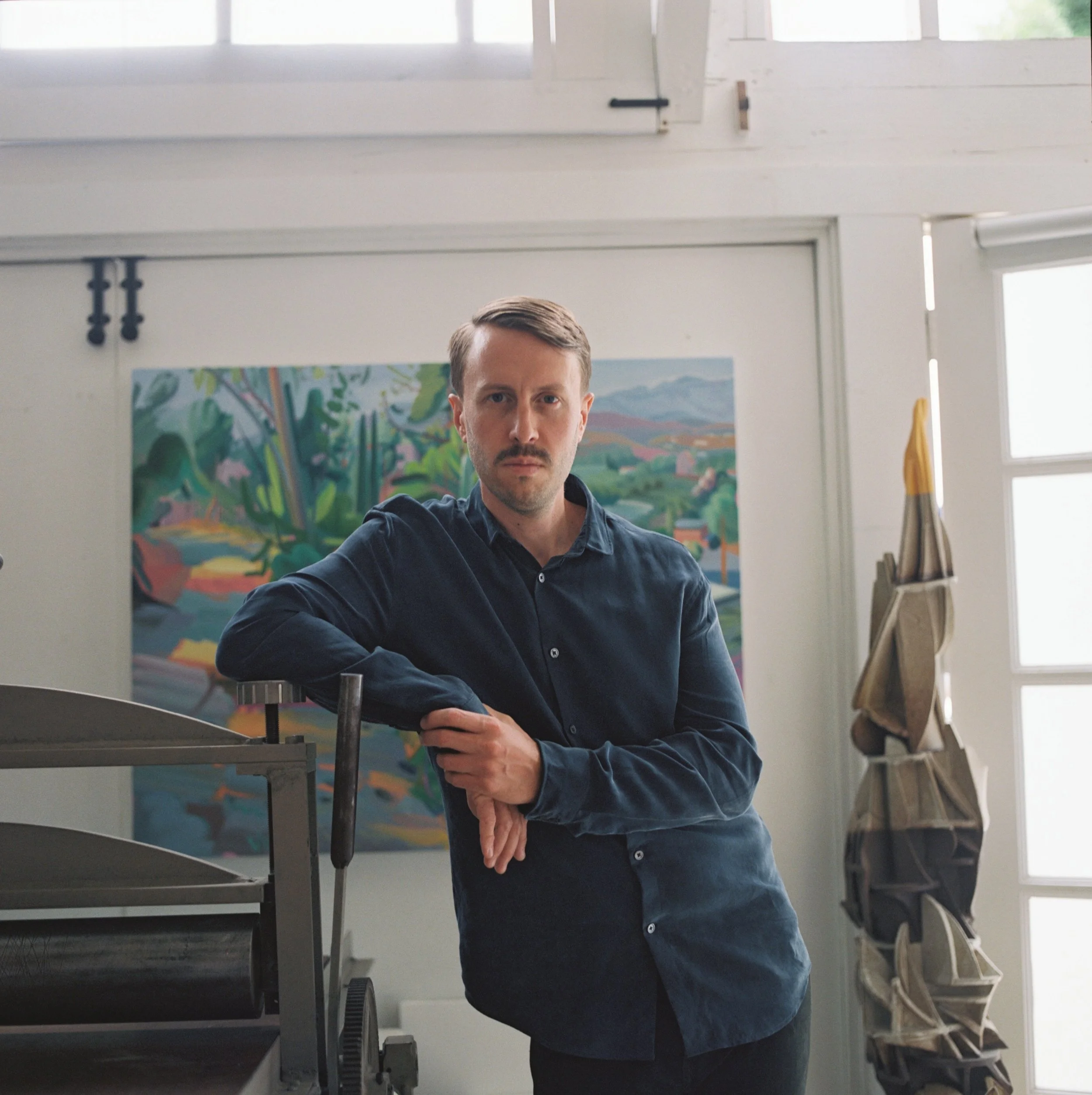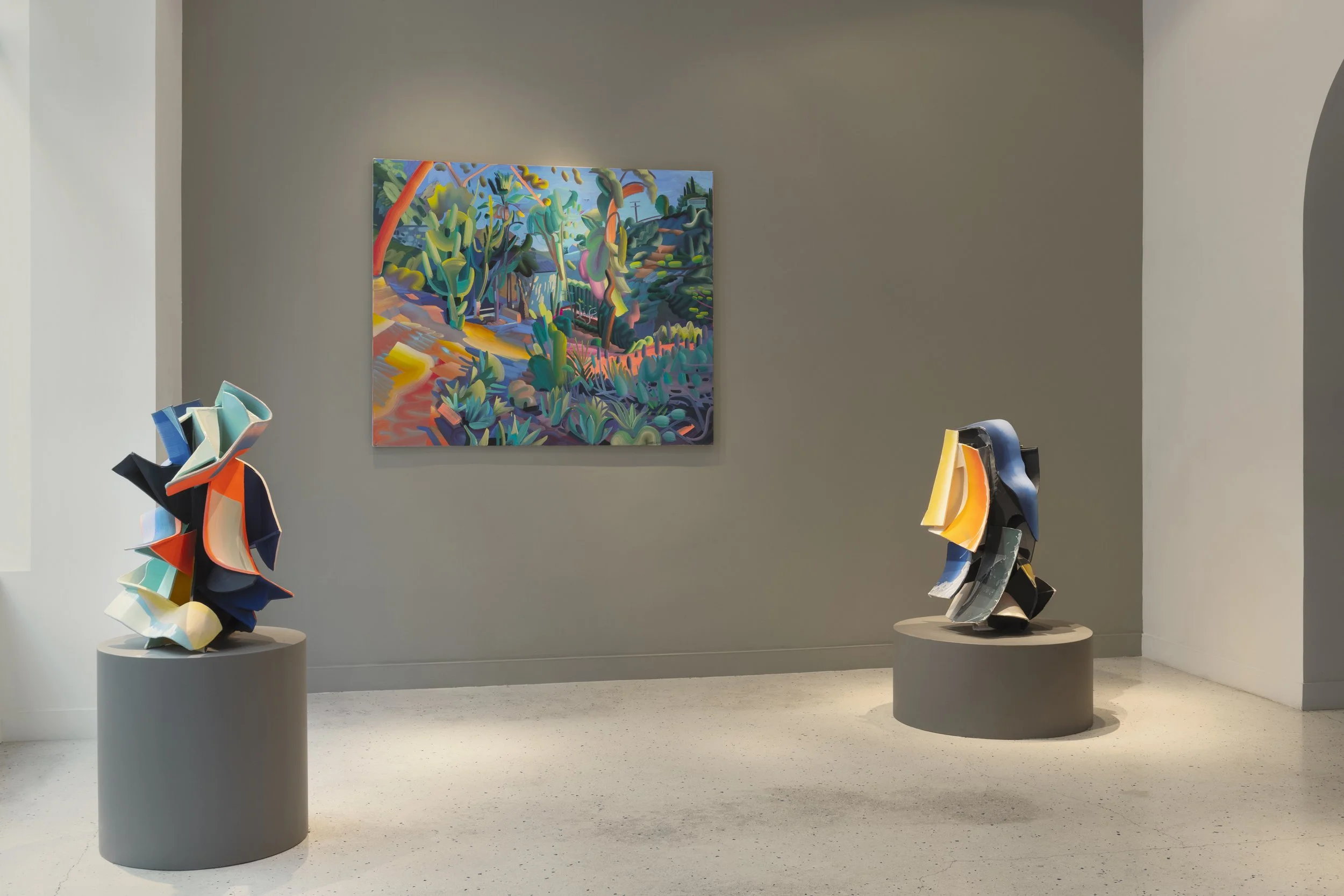Fragments of Identity: Andrew Holmquist
In this exclusive interview, Los Angeles-based artist Andrew Holmquist opens up about his dynamic approach to both painting and sculpture, revealing how his work navigates the complexities of identity, intimacy, and the human experience. Known for his totemic ceramic sculptures and vivid, emotionally charged paintings, Holmquist draws from his background as the child of potters and his early passion for painting to create works that blur the lines between abstraction and figuration. His unique glaze techniques and immersive forms invite a tactile engagement, reflecting his belief in the power of touch and texture to evoke deeper connections.
Next month, check out Holmquist’s work at the inaugural Arrival Art Fair with North Loop West, where his boundary-pushing practice will be on full display.
Your ceramic works, especially the totemic sculptures, showcase a unique approach to glazing that seems to imbue the pieces with both color and texture. Could you discuss your glaze techniques and how they influence the emotional or symbolic readings of these sculptures? Do they reflect an ongoing exploration of identity or narrative?
My parents are potters, and I grew up surrounded by clay, but painting was my first love. The ceramics came later. I approach making sculpture through my experience as a painter, and it is from my paintings that I pull my surface treatments for the ceramics. My sculptures, in a way, have become the most direct form of painting for me. The brushstrokes and gradients of color I generate in my landscape or figurative paintings are untethered and free to float among us in three-dimensional space. In my paintings, now more than ever, the material treatment and scale of marks exceed their intended subject and cross-pollinate from figure to landscape and back again—everything is “vibing” with everything else in a really holistic way. What makes up the air makes up the tree makes up a shaft of light and the side of a face or the curve of a back and the wall it’s pressed against. Identity, a sense of self or being as an integral part of and touched by this broader scenario, is folded into all of this.
For me, painting is wrapped up in touch. Paintings can elicit from the viewer the desire to touch an imaginary form and imagine how it would feel to move our hands across its surface. This unfulfillable invitation, this flirtatious call to the viewer and the ever-withholding power a painting wields is a constant tension in my engagement with the medium. You don’t get to touch paintings, or if you do, the experience doesn’t usually live up to the implied promise. But sculpture is a different story, of course. I have labored to get porcelain—a traditionally, structurally limp material—to withstand my structural requirements so that the faces of my sculptures will benefit from porcelain’s waxy, buttery surface, which begs to be touched in the way a luscious painting does—but with satisfying results, if touching is allowed! I mix ceramic pigments into the brilliant white porcelain and I apply the glaze over the porcelain’s surface using various techniques of combing and brushing. As a final gesture, I will sometimes partially dip a full form into a slime green or Cinderella blue—a sort of ‘90s queer kid palette—glaze that then pools in the crevices and drips in unpredictable ways.
One of the most compelling aspects of your paintings is the interplay between abstraction and figuration, where figures seem to recede and emerge from the background. How do you navigate this fluid transition between abstraction and figuration, and what does it reveal about contemporary identity in the context of your work?
This impulse is rooted in what my moment-to-moment life often feels like—and my experience of living often doesn’t align with the prescribed bounds I was born into in 1985 or continue to live in nearly forty years later. There’s magic that we don’t talk about, which I find pulses through my day in quiet, easily missed ways—moments that splash in waves through me in split seconds and exist simultaneously outside and inside my being, as though running along a Möbius strip. These moments are gifts, but what do you do with them? How do you talk about them when, in many cases, they are so fleeting and beautifully incidental? I use painting to speak to this permeable line between the world and my experience of it. Looking, desiring, touching—longing to touch, light, warmth, a body and the space it inhabits. One mark on a canvas can bend upon itself to describe all of these phenomena simultaneously.
Some of your more intimate works depict quiet moments between you and your partner, such as lounging together or sharing a space like the bathroom. What is the significance of incorporating these personal, tender scenes into your work? How do you think these moments reflect larger themes of intimacy and connection in contemporary queer spaces?
It’s in everyday, small moments where gateways to the sublime open, not just in the operatic moments found in nature. I’m not making overtly political art compared to some, though politically charged content is there because I am showing honest moments from my life, and showing the viewer why those moments, and what they represent, are important to me. At the core of these intimate scenes is love and connection. These are the seismic forces that shook me into recognizing the significance of these moments at the moment they were happening. Thus, intimacy became a crucial theme to revisit in painting. The settings and textures of these private moments are their time stamps. The bottles of soap, Ikea vanities, bookshelves, or exhibition posters pin these moments, these “utopian ruptures,” to a time and place that likewise connect to the person responsible for igniting this response in me. My hope would be that there are enough empathetic handholds in these scenes of embodied and elated queer spaces to connect with viewers, regardless of how closely my details align with their own.
“For me, painting is wrapped up in touch. Paintings can elicit from the viewer the desire to touch an imaginary form and imagine how it would feel to move our hands across its surface. ”
Your paintings feature nods to artists like Alice Neel, Lari Pittman, and Tal R., while also engaging with literary and art historical traditions. Can you discuss the impact of these references on your work, and how they shape the way you address themes of desire, identity, and the human body?
Alice Neel is in some ways responsible for me becoming a painter. When I was in high school, I saw her retrospective at the Walker Art Center and her paintings welcomed me like none had prior to that encounter. The human presence of both the artist and her sitters, and the light-filled, harmonious colors and blunt drawn lines she used to depict them, rang my bell immediately. Seeing the way she looked at and handled beautiful young men in white t-shirts or hirsute naked men, splayed across her canvases, was thrilling in ways I hadn’t yet put into words for myself or to the world. I loved her paintings in a way that exceeded admiration.
Lari Pittman gave a lecture at The Art Institute of Chicago while I was a student at SAIC that shocked me in a way no other lecture had before. In very clear and direct language he talked about the most audacious, fantastical queer world building he played out in his work. The scale of confidence to declare through these giant paintings and in front of this giant crowd that this content was worthy and more than enough, was literally jaw-dropping for me.
Tal R is fearless with the way he allows his life into his paintings. Seemingly unremarkable moments, such as people sitting on benches in a park or at a bar—inspire large paintings and extended bodies of work. Yet right next to these, without skipping a beat, are his paintings anchored to particular desires and fetishes. There’s an uninterrupted conversation across these decibels in his life. They all become a patchwork implying to me that in every moment of our life there is worthy content for illumination.
Painting is inherently a solitary activity, but it is also a vast and ongoing conversation with so many humans throughout history. These are three of many that hold court in my studio on a regular basis.
Your work seems to explore the idea of embodied landscapes and fragmented bodies, where limbs and figures shift and merge. How does this visual fragmentation correlate to your understanding of identity as fluid and evolving, particularly in relation to queer experiences?
There’s less of a script for queer people. The big structures weren’t set in place with us in mind. Without that handed to us, we have to make structures for ourselves. Being on the outside lends itself to new possibilities and tuning in to different frequencies. For me, what I’m picking up is simultaneity. Time spread out and collapsed, overlapping and bending and folding back onto itself. Life doesn’t feel static or simply linear. It is moving and multilayered with crystal moments of unpredictable, delightful alignment that mirror back my interior experiences to the outside, and my past, and the pasts of others, in remarkable congruence with the present. In my paintings, I can physicalize these multidimensional, simultaneous, fleeting moments. All of this experience is a slippery mystery begging for new boundaries to be drawn.
Your exploration of personal memory and imagination in your work often pushes the boundaries of the narrative. How do you balance the personal and the universal in your art, and what role does narrative play in conveying a collective experience of desire or longing?
My paintings have small-scale narratives with profound and lasting effects. If I had to sum them up, they are everyday scenes: sitting along a canal with friends, going to the beach, talking with my new boyfriend on the couch, or years later seeing him sitting in a sunlit room. My paintings often emerge from these multi-layered moments in life that transcend the bullet points. They are instigated by the unanswerable question of how do you render a moment that is both entirely of this world and its specific details, and of a parallel universe that floats two feet above it all? My specific biographical details are there, but they function as onramps into this rapturous ambiguity.
I’ve noticed that after I’ve spent hours painting, everything I encounter out in the world for a spell afterwards is imbued with phenomenal significance. It all matters somehow, and it all fits into an extension of my painting. I have encountered this same experience from looking at artwork in museums intensely, artwork that emerged from floating realms at various, marked moments in time that, to this day, have the power to electrify through to the present moment. What an incredible time portal of collective experience we can take part in, if we let it.









